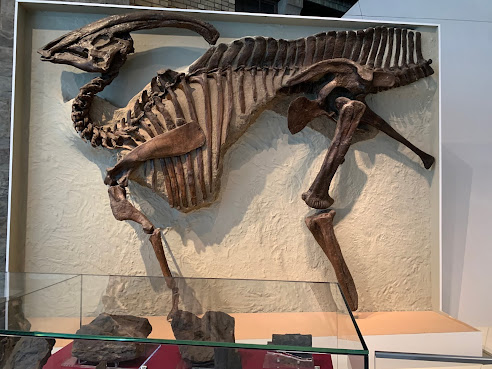On ROM 768, our little mascot
If you haven't noticed, a certain dinosaur skeleton from the Royal Ontario Museum in Toronto, Ontario, Canada has become the blog's background mascot. Its name has been designated as ROM 768.
ROM 768 has long been (literally) overshadowed by Gordo the Barosaurus just metres away from it, yet it has an equally fascinating history and arguably greater impact on the world. It it the holotype specimen of Parasaurolophus and more specifically the type species P. walkeri, arguably the famous and recognisable of the hadrosaur dinosaurs. It’s the most complete specimen of it ever found so far, and indeed very few other specimens have been found. Casts of it have been featured in other museums and attractions worldwide. With its discovery and description, we were led to breakthroughs in the study of communication habits of dinosaurs. Meanwhile, for the last 100 years, most reconstructions of it have borrowed much from it, most notably as a notch over its haunches once thought to be a natural feature, but now known thanks to a 2020 study (Bertozzo et al. 2020) is an injury. The fact that this was made just over a year ago only goes to show how its still revealing so much.
 |
| A drawing of 768 when it was alive, drawn by Marzio Mereggia |
 |
| An old photo of 768 pre-2007 renovation |
I hereby nickname the Parasaur specimen Murrae. Why Murrae? Its derived from the jazz trombonist Murray McEachern, who was born right in Toronto, and because Parasaurolophus walkeri’s crest and sounds has long been compared to trombones. If you wondering why its with an e instead of a y, there’s the issue we have no way of telling whether this parasaurolophus was a male or female, and spelling it that way makes it feel more gender neutral. Although personally I have a hunch Murrae's a male, so make that what you will.
Now I have no doubt that not many more people will call the parasaurolophus Murrae, since 1, I’m lucky if my blog can crack at least 20 views a day without having to rely on Reddit links; 2, I’m 100 years late to coin a nickname that will stick, and 3, the Royal Ontario Museum isn’t likely to adopt the name even if I tell them about it. Nevertheless, I hope that you will spread the word, at least one of you will look at either ROM 768 itself or a cast of it somewhere else, and think “Hey, its Murrae!”
Sources
- Bertozzo, Filippo; Manucci, Fabio; Dempsey, Matthew; Tanke, Darren H.; Evans, David C.; Ruffell, Alastair; Murphy, Eileen (2020). "Description and etiology of paleopathological lesions in the type specimen of Parasaurolophus walkeri (Dinosauria: Hadrosauridae), with proposed reconstructions of the nuchal ligament". Journal of Anatomy. 238 (5): 1055–1069. doi:10.1111/joa.13363. PMC 8053592. PMID 33289113.





Comments
Post a Comment